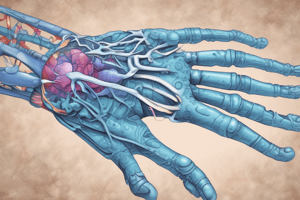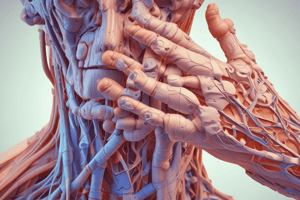Podcast
Questions and Answers
Which drug is a folic acid antagonist and primarily used for its immunosuppressant properties in rheumatoid arthritis?
Which drug is a folic acid antagonist and primarily used for its immunosuppressant properties in rheumatoid arthritis?
- Hydroxychloroquine sulfate
- Sulfasalazine
- Methotrexate (correct)
- Leflunomide
Which DMARD is known for its longer half-life and the risk of hepatic failure?
Which DMARD is known for its longer half-life and the risk of hepatic failure?
- Azathioprine
- Sulfasalazine
- Methotrexate
- Leflunomide (correct)
Which of the following is NOT commonly used as a DMARD due to the availability of better alternatives?
Which of the following is NOT commonly used as a DMARD due to the availability of better alternatives?
- Hydroxychloroquine sulfate
- Leflunomide
- Ciclosporin (correct)
- Methotrexate
What is the primary mechanism of action through which sulfasalazine exerts its anti-inflammatory effects?
What is the primary mechanism of action through which sulfasalazine exerts its anti-inflammatory effects?
What significant side effect is associated with methotrexate treatment?
What significant side effect is associated with methotrexate treatment?
Which drug's therapeutic effect requires co-administration of folic acid supplements to reduce side effects?
Which drug's therapeutic effect requires co-administration of folic acid supplements to reduce side effects?
Which DMARD acts by blocking dihydroorotate dehydrogenase?
Which DMARD acts by blocking dihydroorotate dehydrogenase?
Which side effect is shared by both methotrexate and sulfasalazine?
Which side effect is shared by both methotrexate and sulfasalazine?
Which DMARD is specifically indicated for its anti-inflammatory effects through inhibition of pro-inflammatory cytokines?
Which DMARD is specifically indicated for its anti-inflammatory effects through inhibition of pro-inflammatory cytokines?
What is a major concern when using immunosuppressant drugs like methotrexate and leflunomide?
What is a major concern when using immunosuppressant drugs like methotrexate and leflunomide?
What is the primary goal in treating rheumatoid arthritis early in the disease?
What is the primary goal in treating rheumatoid arthritis early in the disease?
Which drug class is classified as having little effect on disease progression in RA?
Which drug class is classified as having little effect on disease progression in RA?
What is a known side effect of glucocorticoids such as prednisolone?
What is a known side effect of glucocorticoids such as prednisolone?
What type of DMARDs may limit the progression of rheumatoid arthritis?
What type of DMARDs may limit the progression of rheumatoid arthritis?
Which glucocorticoid formulation is designed to release medication in accordance with circadian rhythms?
Which glucocorticoid formulation is designed to release medication in accordance with circadian rhythms?
What mechanism do glucocorticoids primarily use to exert their anti-inflammatory action?
What mechanism do glucocorticoids primarily use to exert their anti-inflammatory action?
What is the method of administration for glucocorticoids mentioned in the content?
What is the method of administration for glucocorticoids mentioned in the content?
Which of the following cytokines is NOT mentioned as being inhibited by glucocorticoids?
Which of the following cytokines is NOT mentioned as being inhibited by glucocorticoids?
What is the potential benefit of using Lodotra over standard prednisone?
What is the potential benefit of using Lodotra over standard prednisone?
In the context of rheumatoid arthritis, which of the following is NOT a part of the overall treatment approach?
In the context of rheumatoid arthritis, which of the following is NOT a part of the overall treatment approach?
What is the primary mechanism of action for drugs that aim to prevent autoimmune responses in rheumatoid arthritis?
What is the primary mechanism of action for drugs that aim to prevent autoimmune responses in rheumatoid arthritis?
Which of the following biological DMARDs is NOT indicated for moderate to severe rheumatoid arthritis?
Which of the following biological DMARDs is NOT indicated for moderate to severe rheumatoid arthritis?
Which of the following targets IL-6 in its mechanism of action?
Which of the following targets IL-6 in its mechanism of action?
In the treatment of rheumatoid arthritis, when is the use of biological DMARDs generally recommended?
In the treatment of rheumatoid arthritis, when is the use of biological DMARDs generally recommended?
What concern is associated with overdosing on certain RA treatments?
What concern is associated with overdosing on certain RA treatments?
Which class of biological DMARDs would likely be prescribed alongside methotrexate in a triplet therapy for rheumatoid arthritis?
Which class of biological DMARDs would likely be prescribed alongside methotrexate in a triplet therapy for rheumatoid arthritis?
Which of the following biological DMARDs is a fusion protein designed to act as a decoy receptor for TNF?
Which of the following biological DMARDs is a fusion protein designed to act as a decoy receptor for TNF?
What is the classification of Sarilumab in the context of RA treatment?
What is the classification of Sarilumab in the context of RA treatment?
Which of the following factors is a critical consideration when using biological DMARDs?
Which of the following factors is a critical consideration when using biological DMARDs?
What is the role of Rituximab in rheumatoid arthritis treatment?
What is the role of Rituximab in rheumatoid arthritis treatment?
Which class of drugs is primarily used in the treatment of rheumatoid arthritis to reduce inflammation and prevent joint damage?
Which class of drugs is primarily used in the treatment of rheumatoid arthritis to reduce inflammation and prevent joint damage?
What is the primary immune response type involved in rheumatoid arthritis?
What is the primary immune response type involved in rheumatoid arthritis?
Which of the following cytokines is NOT typically associated with rheumatoid arthritis?
Which of the following cytokines is NOT typically associated with rheumatoid arthritis?
Which biological drug is specifically classified as a TNF-alpha inhibitor?
Which biological drug is specifically classified as a TNF-alpha inhibitor?
Janus kinase (JAK) inhibitors are primarily used to treat which type of conditions?
Janus kinase (JAK) inhibitors are primarily used to treat which type of conditions?
What complication is most associated with the use of JAK inhibitors in treatment?
What complication is most associated with the use of JAK inhibitors in treatment?
At what point in the disease course of rheumatoid arthritis might a patient experience significant stiffness in the mornings that improves throughout the day?
At what point in the disease course of rheumatoid arthritis might a patient experience significant stiffness in the mornings that improves throughout the day?
Which serological test is considered most specific for diagnosing rheumatoid arthritis?
Which serological test is considered most specific for diagnosing rheumatoid arthritis?
What is the typical treatment approach for rheumatoid arthritis?
What is the typical treatment approach for rheumatoid arthritis?
Which of the following drugs is a synthetic DMARD used in rheumatoid arthritis treatment?
Which of the following drugs is a synthetic DMARD used in rheumatoid arthritis treatment?
Flashcards
Anti-inflammatory drugs for RA
Anti-inflammatory drugs for RA
Medications that work by reducing inflammation but have little effect on the progression of rheumatoid arthritis (RA).
Disease Modifying Anti-Rheumatic Drugs (DMARDs)
Disease Modifying Anti-Rheumatic Drugs (DMARDs)
A group of medications that can potentially slow down the progression of rheumatoid arthritis (RA).
Conventional DMARDs (cDMARDs)
Conventional DMARDs (cDMARDs)
A type of DMARDs that are commonly used to treat rheumatoid arthritis (RA).
Biologics
Biologics
Signup and view all the flashcards
Glucocorticoids
Glucocorticoids
Signup and view all the flashcards
Prednisolone
Prednisolone
Signup and view all the flashcards
Cushing Syndrome
Cushing Syndrome
Signup and view all the flashcards
Lodotra (Prednisolone)
Lodotra (Prednisolone)
Signup and view all the flashcards
Cortisol
Cortisol
Signup and view all the flashcards
Modified release formulation
Modified release formulation
Signup and view all the flashcards
Early-morning stiffness in RA
Early-morning stiffness in RA
Signup and view all the flashcards
What are DMARDS?
What are DMARDS?
Signup and view all the flashcards
What are cDMARDS?
What are cDMARDS?
Signup and view all the flashcards
How does Methotrexate work?
How does Methotrexate work?
Signup and view all the flashcards
How does Leflunomide work?
How does Leflunomide work?
Signup and view all the flashcards
How does Sulfasalazine work?
How does Sulfasalazine work?
Signup and view all the flashcards
What are Biologic DMARDs?
What are Biologic DMARDs?
Signup and view all the flashcards
How are bDMARDS used?
How are bDMARDS used?
Signup and view all the flashcards
What are some examples of bDMARDS?
What are some examples of bDMARDS?
Signup and view all the flashcards
What are some common side effects of DMARDS?
What are some common side effects of DMARDS?
Signup and view all the flashcards
Why is early and aggressive RA treatment important?
Why is early and aggressive RA treatment important?
Signup and view all the flashcards
Biological DMARDs
Biological DMARDs
Signup and view all the flashcards
Anti-TNF-alpha therapy
Anti-TNF-alpha therapy
Signup and view all the flashcards
Anti-IL-6 therapy
Anti-IL-6 therapy
Signup and view all the flashcards
Methotrexate
Methotrexate
Signup and view all the flashcards
Sulfasalazine
Sulfasalazine
Signup and view all the flashcards
Leflunomide
Leflunomide
Signup and view all the flashcards
Triple therapy
Triple therapy
Signup and view all the flashcards
Treatment flowchart: NICE
Treatment flowchart: NICE
Signup and view all the flashcards
Janus Kinase (JAK) Inhibitors
Janus Kinase (JAK) Inhibitors
Signup and view all the flashcards
Tumor Necrosis Factor-alpha (TNF-alpha)
Tumor Necrosis Factor-alpha (TNF-alpha)
Signup and view all the flashcards
Interleukin-1 (IL-1)
Interleukin-1 (IL-1)
Signup and view all the flashcards
Interleukin-6 (IL-6)
Interleukin-6 (IL-6)
Signup and view all the flashcards
Rheumatoid Arthritis (RA)
Rheumatoid Arthritis (RA)
Signup and view all the flashcards
Th1 Immune Response
Th1 Immune Response
Signup and view all the flashcards
Early Morning Stiffness
Early Morning Stiffness
Signup and view all the flashcards
Anti-CCP Antibodies
Anti-CCP Antibodies
Signup and view all the flashcards
Study Notes
Rheumatoid Arthritis Treatment
- Rheumatoid arthritis (RA) is a debilitating autoimmune disease
- The initial impact of RA causes significant disability
- The goal is to control RA early to minimize long-term effects
- Treatment involves: patient education, healthcare professional management, medication, and surgery
Drugs for RA
- Anti-inflammatory drugs: These have little effect on disease progression
- Nonsteroidal anti-inflammatory drugs (NSAIDs)
- COX-2 inhibitors
- Glucocorticoids (e.g., prednisolone)
- Disease-Modifying Anti-Rheumatic Drugs (DMARDs): Compounds that may limit disease progression
- Conventional DMARDs (cDMARDs)
- Biologics
Glucocorticoids (e.g., Prednisolone)
- Useful "bridging" drug
- Administered orally, intramuscularly, or intra-articularly
- Actions: anti-inflammatory and immune suppression
- Inhibit cytokine gene expression (IL-1, IL-2, IL-6, TNFα)
- Inhibit inflammatory cell action (decreasing T cell activity and proliferation)
Side Effects of Glucocorticoids (Cushing Syndrome)
- Euphoria (though sometimes depression or psychosis)
- Emotional lability
- Buffalo hump
- Hypertension
- Moon face (plethoric cheeks)
- Increased abdominal fat
- Avascular necrosis of femoral head
- Easy bruising
- Thinning skin
- Thin arms and legs, muscle wasting
- Poor wound healing
- Osteoporosis
- Tendency to hyperglycemia
- Negative nitrogen balance
- Increased appetite
- Increased susceptibility to infection
- Obesity
Steroid Formulations (e.g., Lodotra)
- Prednisone modified-release formulation
- Activated approximately 6 hours post-ingestion
- Taken with water, after food; do not chew
- Released to coincide with circadian rhythms of cortisol & disease symptoms (peak early morning)
- Studies show improvement in early morning joint stiffness symptoms
DMARDs (Disease-Modifying Anti-Rheumatic Drugs)
- Conventional DMARDs (e.g., methotrexate, azathioprine, cyclosporin, leflunomide, sulfasalazine, sodium aurothiomalate, penicillamine, hydroxychloroquine sulfate)
- Biologic DMARDs
- Effective in limiting disease progression
- 90% of RA joint involvement occurs within the first year; early aggressive treatment is crucial.
DMARDS Effects
- Shown to reduce swelling, pain, and improve joint function
cDMARDs (Conventional DMARDs)
- Methotrexate
- Azathioprine
- Cyclosporin
- Leflunomide
- Sulfasalazine
- Sodium aurothiomalate
- Penicillamine
- Hydroxychloroquine sulfate
Immunosuppressants
- Induce and maintain remission, but impair immune response (i.e., increasing susceptibility to infection)
- Methotrexate and leflunomide are commonly used .
- Azathioprine and ciclosporin are less frequently used due to better alternatives
Methotrexate
- Folic acid antagonist and inhibitor of dihydrofolate reductase. Inhibits DNA synthesis
- Also interferes with IL-1 proinflammatory actions
- Also promotes adenosine release (anti-inflammatory)
- Side effects: myelosuppression, mucositis, GI disorders, hepatotoxicity, pneumonitis, teratogenic
- Co-administration of folic acid supplements reduces myelosuppression and mucositis
Leflunomide
- Prodrug converted to teriflunomide in the body
- Inhibits pyrimidine synthesis (blocking dihydroorotate dehydrogenase)
- Targets rapidly dividing cells (T-cells)
- Used for moderate to severe rheumatoid arthritis
- Side effects: GI disturbances, peripheral neuropathy, risk of hepatic failure
- Long half-life
Sulfasalazine
- Broken down by gut bacteria (azoreductase) to 5-aminosalicylate (5-ASA) and sulfapyridine
- Absorbed into systemic circulation
- Acts in the lumen to have anti-inflammatory effects
- Therapeutic use through inhibition of PGs and LTs, and pro-inflammatory cytokines (IL-1, TNFα)
- Side effects: GI disturbances, malaise, headache, severe adverse reactions (including reduced WBC counts, caused by sulfapyridine)
Hydroxychloroquine sulfate
- Weak DMARD with a slow onset of action
- Prevents antigen processing by immune cells, preventing immune response
- Effective against autoimmune responses
- Use in mild RA, with methotrexate and sulfasalazine (triple therapy)
- Potential serious side effects (especially with overdose), including cardiovascular and psychiatric effects
Biological DMARDs
- Many treatment options (see Canvas)
- Recommended when conventional therapies are ineffective
- Target numerous pathways in RA, specifically TNF alpha, other cytokines (e.g., IL-6), and other targets
- Examples include: Etanercept, Infliximab, Anakinra, Abatacept, Tocilizumab, Sarilumab, Rituximab
International Non-Proprietary Names (INNs) for Antibodies
- Provides common names for antibodies used in RA treatment across different origins (Chimeric, Humanised, Human) e.g., Infliximab, Tocilizumab, Sarilumab
Immunogenicity
- Different antibody origins (murine, chimeric, humanized, human) exhibit varying levels of immunogenicity (i.e., a reduced reaction from the body)
Biological Therapy for RA
- Includes drugs such as Etanercept, Infliximab, Anakinra, Abatacept, Tocilizumab, Sarilumab, Rituximab
- Used in conjunction with methotrexate (MTX)
- Targeting TNF, IL-1, IL-6 receptor, and other targets
Treatment Flowchart NICE
- Mono-therapy with cDMARDs (MTX, Leflu, Sulfasalazine, Hydroxychloroquine) for mild cases
- MTX with Biological therapies (TNFalpha inhibitors)
- Other biological drugs (e.g., Rituximab) with or without MTX
- Other biological drugs (e.g., Sarilumab, tocilizumab) with or without MTX
Other Compounds
- Synthetic DMARDs (e.g., tofacitinib, baricitinib, upadacitinib)
- Janus kinase (JAK) inhibitors
- Used under expert supervision
- Risks include: cardiovascular events, venous thromboembolism, malignancies, serious infections, and increased mortality
Rheumatoid Arthritis vs. Osteoarthritis
- Differentiated based on features like joint involvement patterns (symmetrical/asymmetrical), presence of nodules, and morning stiffness duration, cartilage loss, inflamed synovium
- RA is autoimmune, while osteoarthritis is degenerative
Key Differences between RA and OA
These are summarized in a table
Self-Assessment Questions
- Questions about RA diagnosis, pathogenesis-implicated cytokines, differences between anti-inflammatory and immunosuppressant drugs, and biological drugs used for treatment.
Studying That Suits You
Use AI to generate personalized quizzes and flashcards to suit your learning preferences.




